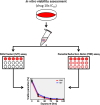Clinically applicable parasite viability assay for rapid assessment of antimalarial pharmacodynamic endpoints
- PMID: 40526071
- PMCID: PMC12326963
- DOI: 10.1128/aac.01863-24
Clinically applicable parasite viability assay for rapid assessment of antimalarial pharmacodynamic endpoints
Abstract
Evaluating the efficacy of antimalarial drugs is crucial in the fight against malaria, as the parasiticidal effectiveness of these drugs often predicts their clinical success. Parasite Reduction Ratio (PRR) assay is the current method of choice for assessing antimalarial's ability to halt parasite recovery after treatment; however, it is time-consuming and resource-intensive, making it less ideal for low-resource or clinical settings. Recent advancements in parasite viability assessment, such as use of the MitoTracker (MT) which probes stain active mitochondria in live cells, provide a faster way to distinguish live from dead parasites using the flow cytometry, providing, thus, timely insights to inform treatment outcomes in clinical trials. In this study, the accuracy of direct viability assessment (DVA) of the parasite using MT staining was compared with the previously established PRR assay to evaluate the efficacy of four reference antimalarial drugs (dihydroartemisinin, chloroquine, atovaquone, and pyrimethamine) using P. falciparum 3D7 strain. Additionally, a mathematical model was developed to estimate key parameters, such as maximum killing rate and lag phase. The model yielded comparable values for these compounds across both assays reinforcing the reliability of the DVA assay for rapidly assessing antimalarial drug efficacy. In conclusion, the DVA relies on specialized equipment and technical expertise. However, it can emerge as an alternative to the PRR, offering a faster and more clinically suited approach for studies.
Keywords: MitoTracker; Plasmodium; parasite viability; parasite reduction ratio; pharmacodynamics.
Conflict of interest statement
C.D.-G., and T.S. are employed by Ares Trading S.A., Switzerland, an affiliate of the healthcare business of Merck KGaA, Darmstadt, Germany. S.G.W. consultancy was funded by the healthcare business of Merck KGaA, Darmstadt, Germany. All other authors declare no competing interest.
Figures





References
-
- Walz A, Duffey M, Aljayyoussi G, Sax S, Leroy D, Besson D, Burrows JN, Cherkaoui-Rbati MH, Gobeau N, Westwood M-A, Siethoff C, Gamo F-J, Mäser P, Wittlin S, The Parasite Reduction Ratio (PRR) . 2023. The parrasite reduction ratio (PRR) assay version 2: standardized assessment of Plasmodium falciparum viability after antimalarial treatment in vitro. Pharmaceuticals (Basel) 16:163. doi: 10.3390/ph16020163 - DOI - PMC - PubMed
-
- Radohery GFR, Walz A, Gumpp C, Cherkaoui-Rbati MH, Gobeau N, Gower J, Davenport MP, Rottmann M, McCarthy JS, Möhrle JJ, Rebelo M, Demarta-Gatsi C, Khoury DS. 2022. Parasite viability as a measure of In vivo drug activity in preclinical and early clinical antimalarial drug assessment. Antimicrob Agents Chemother 66:e0011422. doi: 10.1128/aac.00114-22 - DOI - PMC - PubMed
Publication types
MeSH terms
Substances
LinkOut - more resources
Full Text Sources

